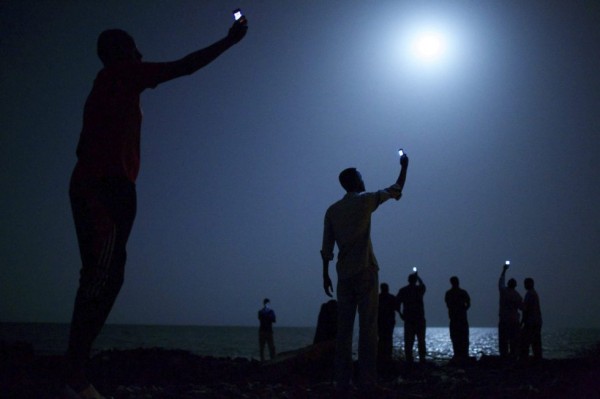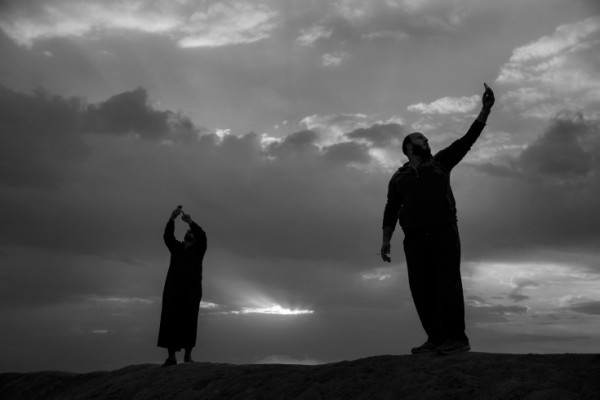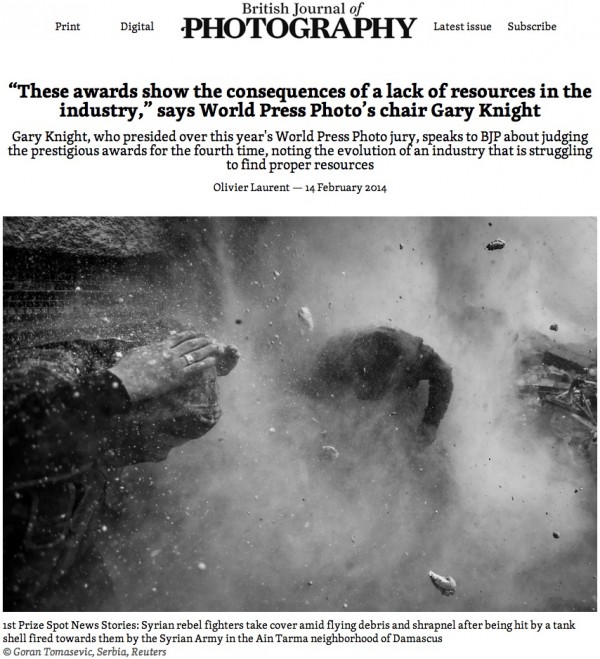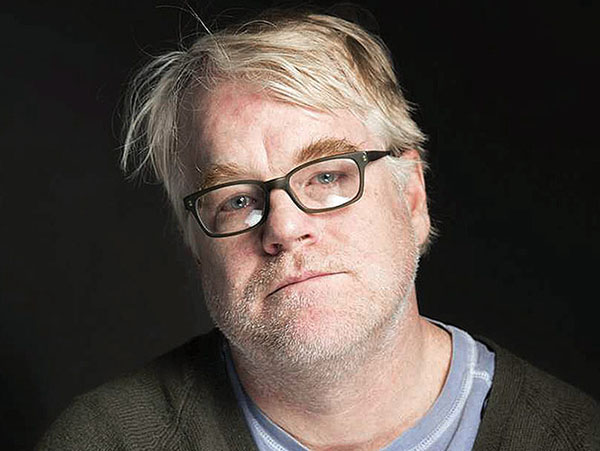Notes
Thoughts on John Stanmeyer's 2014 World Press Winning Photo
“Are some issues more important than others, and to what extend should we bare that in mind, if at all. Did we want to make statements? And what would they be? The conclusions we came to were that there’s no hierachy of issues and that we didn’t want to make any statements. What we wanted to do was to judge the skills and abilities of the photographers who entered.
— Contest Jury Chair, Gary Knight (BJP)
On taking a stand
I have to admit, it’s painful to me that World Press Photo, with its history and credibility and visibility, doesn’t use its platform to make a ethical and moral statement with its photo of the year. With all the intractable crises in the world and the growing role and visibility of news photography (the contest is about news and journalism, after all, no?), I have to take a deep swallow in reminding myself that World Press is not the Nobel.
That said, I did feel relieved that John Stanmeyer’s winning photo was that visually distant from the political subject matter it represents. If the controversy surrounding last year’s winner by Paul Hansen undermined the photo’s relevance to the Israeli – Palestinian conflict (those technical issues mostly relevant to the photo tribe), Stanmeyer’s image is so beautiful and abstract, I can’t imagine immigrants in Djibouti, or immigrant advocates anywhere feeling that affected or disaffected by it.
Universal or generic?
Regarding the subject matter itself, you could argue this photo is universal, as jurist Suzie Linfield states. Just as much though, you could call it generic.
In a day and age where specific conflicts (Syria, Egypt, Ukraine) and atrocities or human rights abuses (exploitation of garment workers in Bangladesh, domestic violence) beg for poignancy and advocacy, feting Stanmeyer’s photo can either be seen as the loss of an opportunity to make a conscience statement, or else an incredibly daring choice inviting a number of conversations about what the photo is/ isn’t and does/doesn’t. (What’s actually most scary to me is the photo being widely adulated with warm, fuzzy, but unelaborated approval.)
Appealing to the Heavens
It does seem significant, somehow, that Stanmeyer’s photo from the Djibouti shore is that similar to James Nachtwey’s photo from the Syrian Za’atari refugee camp in Jordan.
James Nachtwey’s photo for TIME, by the way, was created later, taken just a few months ago, in December. Stanmeyer’s photo, in contrast, was taken almost a year ago, on February 26, 2013.
In contrast to Stanmeyer’s image, the Nachtwey photo plays with the trappings of piety and works as more of an appeal to God and the heavens, the sun’s rays a metaphor for faith and the Almighty; the woman’s dress apropos of “olden times.” (To the extent the photo raises the issue of faith and God, by the way, if just in bestowing bandwidth, how often does a news photo go there these days??)
Stanmeyer’s photo (by way of the color and the presence of the moon rather than the sun) is more “secular” and sexy. It’s more “Close Encounters” to Nachtweys’ “The Ten Commandments.” If Stanmeyer’s photo covers Nachtwey’s register, it’s so suggestive you would hardly know from Djibouti. Certainly, it leveraged faith in a much more ironic way though. If Nachtwey’s refugees are appealing to God for service, Stanmeyer’s immigrants loft and cast their eyes to the technology like it is our God).
The Blue I’ll Remember
I’m also interested in how this photo throws color and light down on the discussion table for the eye, the senses, in precedence to its story. I’m curious about the tension between color and content, the color here being more subject than accent.
Of course that blue and its gradient is the star of the photo. It’s not just cool, it’s extraordinarily cool –it’s Jazz cool. To the extent that news photos these days pulse with color, or seduce us with pleasing tones and meditated palettes, perhaps the fact were drenched with it here calls for not just good biorhythms, but some discussion.
If it looks like a cell phone ad, is that such a bad thing?
The first reaction to the award I read was exactly one line: “It looks like a Nokia advertisement.” Hearing this from someone in the photo world I greatly respect, I appreciated the blatancy. In my mind, at least, this photo screams out the influence of advertising and the ever-increasing intermingling between commercial and editorial imagery. (I’m still convinced those movie posters played prominently, and added more charge to Tyler Hick’s cinematic images from that horrific mall massacre in Nairobi.)
On one level, absolutely, this is an Apple or a Samsung ad. (Back to God or Big Brother, this reminded me right away of the Apple 1984 ad.) And, in contrast to Nachtwey again, those stylish poses, those rolled up sleeves of the central and figure in Stanmeyer’s shot practically shout “hipster!” If you asked people to look at this photo and say every word that came to mind, I wouldn’t be surprised at all if someone said “demographics.”
Why, by the way, should aesthetics or photo processing command all that attention when it comes to what’s controversial about news photography these days? To the extent Stanmeyer’s photo provokes discussion of a winning look and commercial allusions, I say, bring in on.
Concerned Telecom
I’m probably going to contradict myself a little bit, decrying the absence of statement-making in this award. But doesn’t the photo invite the analysis of telecommunications as a resource, as a human right, in fact? And then, if it does nothing else, doesn’t it impel a conversation about the digital divide, about the digi-haves and have nots? Of course, elevating cell access in Africa to this level of visibility should invite dialogue. If we’re really giving Stanmeyer his due, shouldn’t we be discussing where, for example, this issue falls in comparison to the politics of water or climate change?
And a few words about conflict of interest
Barely a day after the awards were announced, concern was raised about conflict of interest given Gary Knight’s membership in the VII agency along with Stanmeyer. On one side, you can read the post by the outspoken duckrabbit, or Benjamin Chesterton, charging incest. This post by Paul Melcher (Thoughts of a Bohemian) takes the opposite and what one might call a hyper-practical argument: the main thesis being that the industry is so small, such intermingling is unavoidable.
This kerfuffle, though, obscures a larger ethical dilemma sounded most loudly by Mr. Knight immediately after the awards were announced, the scoop published by the British Journal of Photography blog (and illustrated by a winning Reuters photo) thusly:
Mr. Knight’s lament and warning about the dominating impact of “Big Photo” is, in my mind, the largest story to come out of World Press Photo 2014. If the industry is so weak, and the (independent) photographers are so scarce, and the subject matter by non-corporate entities so thin, I’m less worried about Mr. Knight of VII voting for Mr. Stanmeyer of VII, than Mr. Knight voting for Mr. Stanmeyer, who has been shooting for National Geographic for a decade. (… And, wouldn’t it have been cool if Mrs. Obama had been Instagramming, instead, for NOOR or Panos or Prime or GRAIN or Facing Change?
Are @NatGeo @nytimes @AP @AFP and @Reuters really that dominant when it comes to quality stories and viable choices for elite photo awards, or are we thinking and hearing that because the photojournalism world is so small and these organizations, as intermingled as they are with the community, exercise that much influence and earn that much deference?
Surveying the winning World Press photos, one can feel satisfaction that many photographers and projects were selected this year that weren’t commissioned or procured out of a corporate suite or through well worn relationships. If the choice of Mr. Stanmeyer’s photo is to be more than just a crowd pleaser, let part of the discussion have to do (inspired by those immigrants hungry for a signal) with photojournalism sharing the juice.
update 1: language edited to clarify that Nachtwey’s image was photographed later than Stanmeyer’s
update 2: In raising the issue of conflict of interest here, it’s important to cite David Campbell’s very thorough and highly informative piece posted this morning, World Press Photo 2014 contest: Reflections from the Secretary’s seat. A snippet:
World Press Photo has been judging professionals annually for nearly sixty years and retains considerable respect and status within the international photographic community. While I am Secretary I want people who question the contest to do so from as informed a position as possible.
…
I hope those wanting to continue the debate will take the time to read it closely, because a good critique depends on some knowledge of what you are talking about.
(photo: John Stanmeyer/VII Photo for National Geographic)





Reactions
Comments Powered by Disqus